Using the IAHSS
Step 1. Access the IAHSS
Access to the IAHSS requires TOMS logon credentials (i.e., username and password).
- Open a web browser and navigate to the CAASPP website.
-
Select the [Smarter Balanced Interim Assessments] button (figure 1) to navigate to the CAASPP Interim Assessment Administration Resources web page.
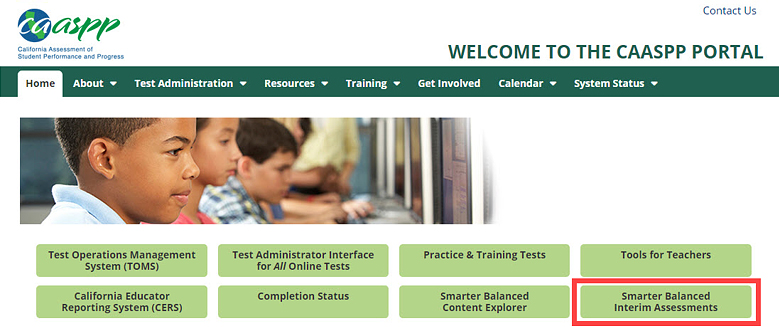
Figure 1. [Smarter Balanced Interim Assessments] button on the CAASPP website
-
Select the [Interim Assessment Hand Scoring System] button (figure 2).
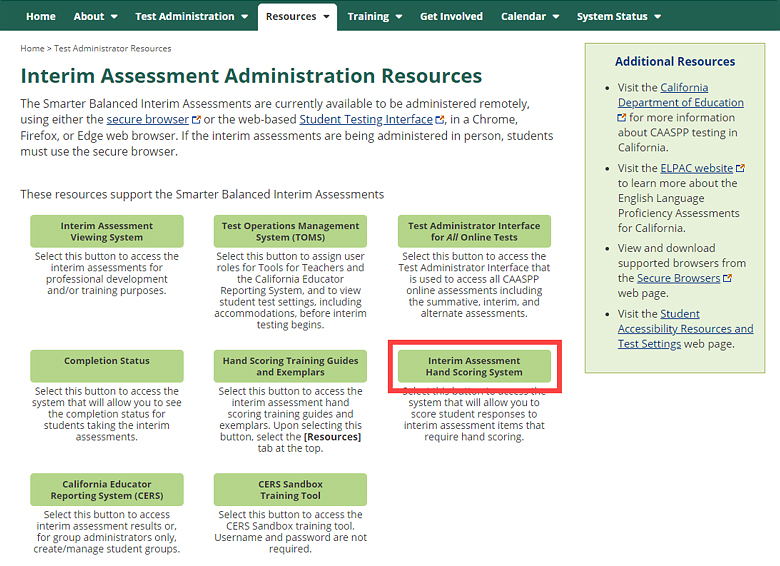
Figure 2. [Interim Assessment Hand Scoring System] button
- Enter the required email address and password in the Email Address and Password fields on the Logon screen (figure 3), and then select the [Secure Logon] button.
- If the password has been forgotten or otherwise needs to be reset, select the [Forgot Your Password?] link on the Logon screen and follow the directions provided.

Figure 3. Logon screen
Step 2. Select Item Responses to Score
Overview of the Response List Page
After logging on, the Response List page will appear (figure 4). For scorers, this table populates with the responses assigned to a scorer for scoring. Descriptions of the callouts on figure 4 appear after the figure.
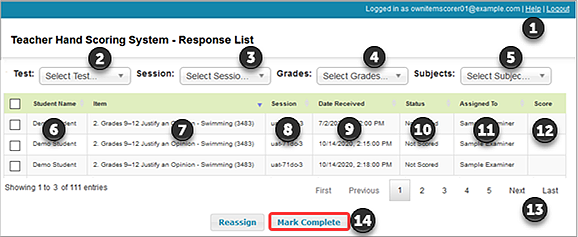
Figure 4. Response List page
- [Help] button: This button opens the Teacher Hand Scoring System User Guide.
- Test drop-down list: This list is used to filter the response list by test.
- Session drop-down list: This list is used to filter the response list by session ID.
- Grades drop-down list: This list is used to filter the response list by grade level.
- Subjects drop-down list: This list is used to filter the response list by subject.
- Student Name: This column indicates the student’s name.
- Item: This column indicates the name of the hand scored item. It includes item ID and name.
- Session: This column provides the session ID in which the assessment was completed.
- Date Received: This column provides the time and date on which the item response was added to the system.
- Status: This column provides the scoring status of the item. Refer to table 1 for information on status types.
- Assigned To: This column indicates the scorer to whom the response is currently assigned to.
- [Score] button: This button is selected to score a student response.
- Navigation links: These links are used to view student responses on other screens, if the response list shows more than 25 students.
- [Mark Complete] button: This button completes the hand scoring for selected responses; responses will no longer be available.
| Status | Meaning |
|---|---|
| Not Scored | This status indicates that the response needs to be scored. |
| Tentatively Scored | This status indicates that the response was scored but needs to be marked as complete. The response is still available to be reviewed or reassigned. |
Filter the Response List Table
Use the drop-down lists on the Response List page to filter the responses that appear in the table. Scorers can filter the table by test or session. Score managers can filter the table by test, session, grade, subject, or assigned scorer.
-
Open a drop-down list above the Response List table (figure 5). For a scorer, the options are Test and Session.
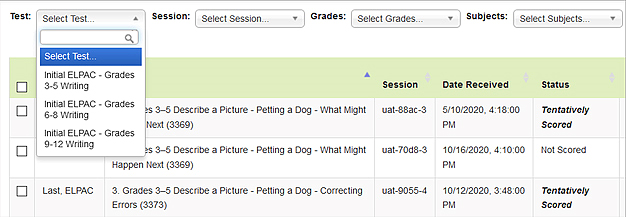
Figure 5. Test Filter for the Response List table—Scorer
- Select an option; otherwise, enter the desired option in the search field. The table updates to show only responses associated with the selected option.
- To apply additional filters, repeat steps 1 and 2 with a different drop-down list.
Sort the Response List Table
The Response List table can be sorted by student name, item, session ID, or response status.
- Select a column header. The table lists the responses by that column in ascending order.
- To sort the responses in descending order, select the column header again.
Step 3. Score Item Responses
When scoring responses, either assign a score to the response or mark it with a condition code. Condition codes are used for any item that cannot be scored because of the nature of the student’s response. When a student response is assigned a condition code, it is equivalent to a score of zero, with the exception of the “off-purpose” code.
Refer to the Hand Scoring Condition Codes subsection for more information on condition codes.
If a single item is scored using multiple scoring criteria (i.e., ELA full writes are scored for organization/purpose, evidence/elaboration, and conventions, and would receive three separate scores), a scorer should enter a score or condition code for each criterion. For more information about how to score responses and use condition codes, refer to the Smarter Balanced Hand-Scoring Rules web document.
Score Responses
This section explains how to enter scores and condition codes for responses.
-
In the Score column of the Response List table (figure 5), select [Score]. The Score Response page appears, displaying the item rubric and student response (figure 6).
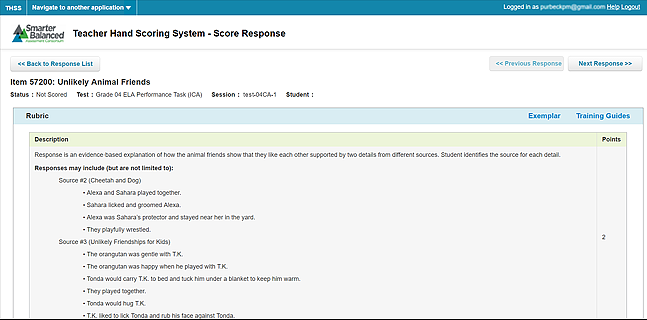
Figure 6. IAHSS Score Response page
-
In the “Response” section of the Score Response page (figure 7), review the item prompt and the student’s response. Table 2 defines the terms used in figure 7.
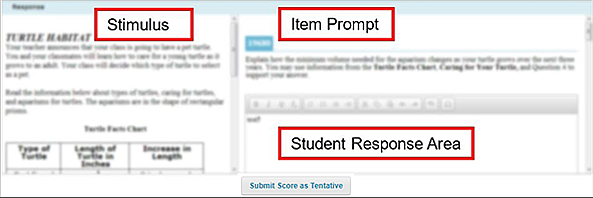
Figure 7. IAHSS “Response” section
The three parts of the “Response” section (figure 7) are described in table 2.
Table 2. “Response” Section Terms
Term Definition Stimulus The stimulus is material used in the test context that forms the basis for assessing the knowledge and skills of students. Many items and tasks for the assessments include a stimulus along with a set of questions to which the student responds. Stimulus materials are used in ELA and mathematics assessments to provide context for assessing the knowledge and skills of students and are diverse. These stimulus materials can be traditional reading passages and texts but viewed on a computer screen, images with audio presentations for students listening, simulated web pages for students to use for research, or scenarios for student response. Item Prompt The prompt is a test question or stimulus presented to a student to elicit a response. (This is also referred to as an item stem.) Student Response Area This is the designated area for the student’s response to the item prompt. - In the “Rubric” section (figure 8), review the rubric description and complete the following steps:
- In the “Scoring” section, enter a score for the response. Manually enter a numerical score in the Score field or use the arrow button in this field to increase or decrease the score in increments of one (figure 9). The score cannot exceed the value in the Points column. If the item consists of multiple scoring criteria, repeat this step for each criterion.
-
If necessary, assign a condition code to the response. Select the appropriate option from the Condition Code drop-down list (figure 9).

Figure 9. IAHSS “Scoring Criteria” section
- In most cases, when a full write essay receives a condition code, the code is assigned to all writing traits of the response. However, there is a new rule for the 2022–23 test administration regarding the “off-purpose” condition code. If the condition code for an essay is “off purpose,” only the evidence/elaboration and organization/purpose writing traits are assigned “off purpose,” and the conventions writing trait is still scored (figure 10). This conventions item score is included in the total ELA score and the writing claim score. The rule for “off-purpose” scoring of conventions is applied to ELA full write Performance Tasks regardless of the genre of writing prompt.

Figure 10. IAHSS “Scoring Criteria” section scored with the “off-purpose” condition code
-
- After finishing entering scores for the response, select [Submit Score as Tentative] at the bottom of the page (figure 7).
- To navigate to the Score Item page for a different item, select [Previous Response] or [Next Response] at the top of the page (figure 11). The order of responses is determined by the sorting options chosen on the Response List table.
- To return to the Response List page, select [Back to Response List]. The item’s status in the Status column now displays “Tentatively Scored.”

Figure 11. Navigation for the IAHSS
How to Reassign Responses
Score managers at the school level (test site coordinators) can reassign responses to scorers in a school. Those score managers associated with an LEA (LEA CAASPP coordinators) can reassign responses to scorers within the LEA.
What follows is the process for score managers to reassign responses.
-
On the Response List table (figure 12), mark the checkbox in the column on the far left for any items intended to be reassigned.
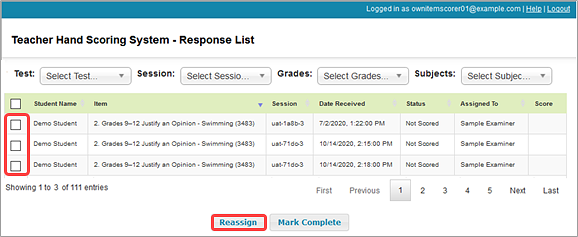
Figure 12. Response List table
- Select the [Reassign] button at the bottom of the Response List page. A dialog box pops up.
-
In the Reassign Selected Responses dialog box (figure 13), select a scorer from the drop-down list. Only users associated with the user’s school or LEA will appear.
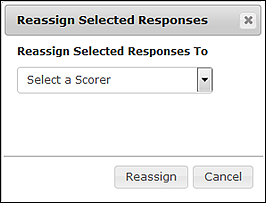
Figure 13. Reassign Selected Responses dialog box
- Select the [Reassign] button. The selected responses are reassigned to the selected scorer. The newly assigned scorer’s name will show in the Assigned To column of the Response List table.
Step 4. Mark Item Responses as Complete
After scoring responses, the scorer must mark the responses as complete to finish the process. The completed response will advance in the process to ultimately generate a score in CERS.
-
On the Response List table, mark the checkbox for any responses that have final scores (figure 14).
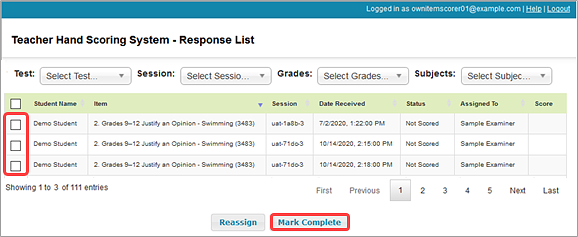
Figure 14. Response List table
- Select the [Mark Complete] button (figure 13).
- In the window that pops up, select the [Mark Complete] button. Once a response has been marked as complete, it is removed from the scorer’s queue.
Interim assessment score results are generally available within 20 minutes once all hand scoring has been completed. The results can be viewed in CERS. Because of regular quality assurance processes and the high volume of testing during peak summative testing times, some results might require more than 20 minutes to populate in CERS.
Teachers will need permission, by way of a TOMS role, to view test results for their student groups, which are created by the LEA or site coordinator. Teachers who are unable to view their student groups should contact their school or LEA coordinator.
School administrators may view results for all students in the school, and LEA administrators may view results for all students in the LEA.


